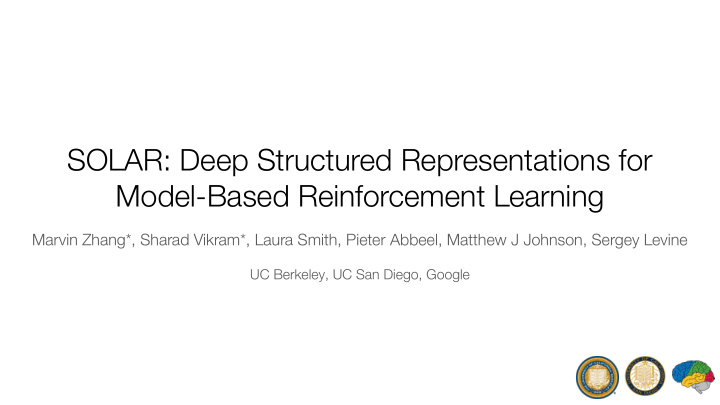



SOLAR: Deep Structured Representations for Model-Based Reinforcement Learning Marvin Zhang*, Sharad Vikram*, Laura Smith, Pieter Abbeel, Matthew J Johnson, Sergey Levine UC Berkeley, UC San Diego, Google
Efficient reinforcement learning from images
Efficient reinforcement learning from images Model-free RL: 4 hours for image-based robotic task, 2 hours for block stacking from states https://sites.google.com/view/sac-and-applications
Efficient reinforcement learning from images Model-free RL: 20 hours for image-based robotic task, 2 hours for block stacking from states Model-based RL from images: relies on accurate forward prediction , which is difficult
Efficient reinforcement learning from images Model-free RL: 20 hours for image-based robotic task, 2 hours for block stacking from states Model-based RL from images: relies on accurate forward prediction , which is difficult Key idea: structured representation learning to enable accurate modeling with simple models; model-based method that does n o t use forward prediction
Preliminary: LQR-FLM Levine and Abbeel, “Learning Neural Network Policies with Guided Policy Search under Unknown Dynamics”. NIPS 2014. Levine*, Finn*, Darrell, and Abbeel, “End-to-End Training of Deep Visuomotor Policies”. JMLR 2016. Chebotar*, Hausman*, Zhang*, Sukhatme, Schaal, and Levine, “Combining Model-Based and Model-Free Updates for Trajectory-Centric Reinforcement Learning”. ICML 2017.
Preliminary: LQR-FLM LQR-FLM fits local models for policy improvement, not forward prediction Levine and Abbeel, “Learning Neural Network Policies with Guided Policy Search under Unknown Dynamics”. NIPS 2014. Levine*, Finn*, Darrell, and Abbeel, “End-to-End Training of Deep Visuomotor Policies”. JMLR 2016. Chebotar*, Hausman*, Zhang*, Sukhatme, Schaal, and Levine, “Combining Model-Based and Model-Free Updates for Trajectory-Centric Reinforcement Learning”. ICML 2017.
Preliminary: LQR-FLM LQR-FLM fits local models for policy improvement, not forward prediction LQR-FLM has worked on complex robotic systems from states Levine and Abbeel, “Learning Neural Network Policies with Guided Policy Search under Unknown Dynamics”. NIPS 2014. Levine*, Finn*, Darrell, and Abbeel, “End-to-End Training of Deep Visuomotor Policies”. JMLR 2016. Chebotar*, Hausman*, Zhang*, Sukhatme, Schaal, and Levine, “Combining Model-Based and Model-Free Updates for Trajectory-Centric Reinforcement Learning”. ICML 2017.
Preliminary: LQR-FLM LQR-FLM fits linear dynamics and quadratic cost models for policy improvement:
Preliminary: LQR-FLM LQR-FLM fits linear dynamics and quadratic cost models for policy improvement: This works well, even for complex systems, if the state is relatively simple, but this doesn’t work if the state is complex, such as images
Our method: SOLAR In this work, we enable LQR-FLM for images using structured representation learning
Our method: SOLAR In this work, we enable LQR-FLM for images using structured representation learning
Our method: SOLAR In this work, we enable LQR-FLM for images using structured representation learning
Our method: SOLAR In this work, we enable LQR-FLM for images using structured representation learning
Our method: SOLAR In this work, we enable LQR-FLM for images using structured representation learning
Our method: SOLAR In this work, we enable LQR-FLM for images using structured representation learning
Real robot results Our method is more efficient than both prior model-free and model-based methods
Real robot results Our method is more efficient than both prior model-free and model-based methods Block stacking: we can transfer a representation and model to multiple initial arm positions
Real robot results Our method is more efficient than both prior model-free and model-based methods Mug pushing: We can solve this task from sparse reward using human key presses
Thank you Poster #34 Paper: https://arxiv.org/abs/1808.09105 Website: https://sites.google.com/view/icml19solar Blog post: https://bair.berkeley.edu/blog/2019/05/20/solar Code: https://github.com/sharadmv/parasol
Recommend
More recommend